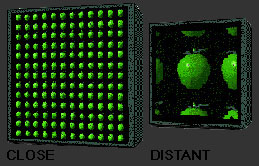
Patent
Displaybox

Method of providing a magnified image of a periodical image pattern. US patent 5.812.313
Inventors: Henrik Boëtius and Frithioff Johansen
The very simple principle behind the patent is interference between an image carrying plane and a neutral reference plane. By means of a moiré effect, two interfering structures form a new structure. If one of the structures acts as a reference for the other structure, a very sharp, magnified image of the second structure is generated. If the interfering structures are in the same plane, the generated magnified image will be in the same plane as the interfering structures. If the interfering structures are in different planes, a virtual image arranged therebehind is generated. At the same time, a stereoscopic depth effect is obtained.
A simple display
Description of a displaybox illustrating the visuel effect of the patent. The box uses a backlit "sandwich" of two plates.
As a visual experience the display is most interactive with the spectator, because it causes a total transformation of our traditional perception of space, upsetting wellknown laws and depth cues around the linear perspective.
Because the image generation does not take place at the surface of the display but of the next underlying plate - a canceling of the surface as matter will take place. The outside plane will seem airy, almost transparent, and the images of the display will appear floating somewhere inside -perhaps even behind - the box.
The experience of dynamic paralaxis - which normally decreases with the distance - is constant in this situation. Even at a long distance you do not need much change of viewing angle to get the same relative change of the total image. At the same time the laws of perspective are upset - the total image growing in size the greater the distance.
Imagine that, at a close distance, you see 300 green apples. However looking at the display at a certain longer distance, you will only see one apple. The parameters of the system are easy to adjust, so that they can be - so to say - tailored into a given space. Beyond the changes in image size the display also renders a true 3-d image. As you wish you can tilt the image plane forwards or backwards, and the virtual image will be generated in a plane going beyond the space of the box.
The strength and force of this display is its extraordinary simple concept and construction. Almost like a hologram it violates the traditional image space without the need of expensive electronic feedback devices. Presumably the method will be of most use in large scale displays.